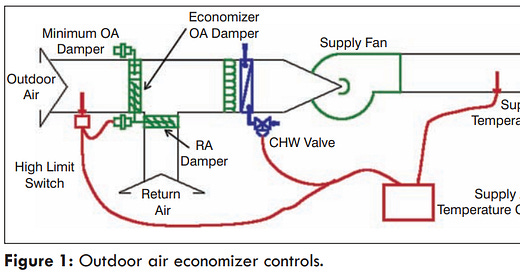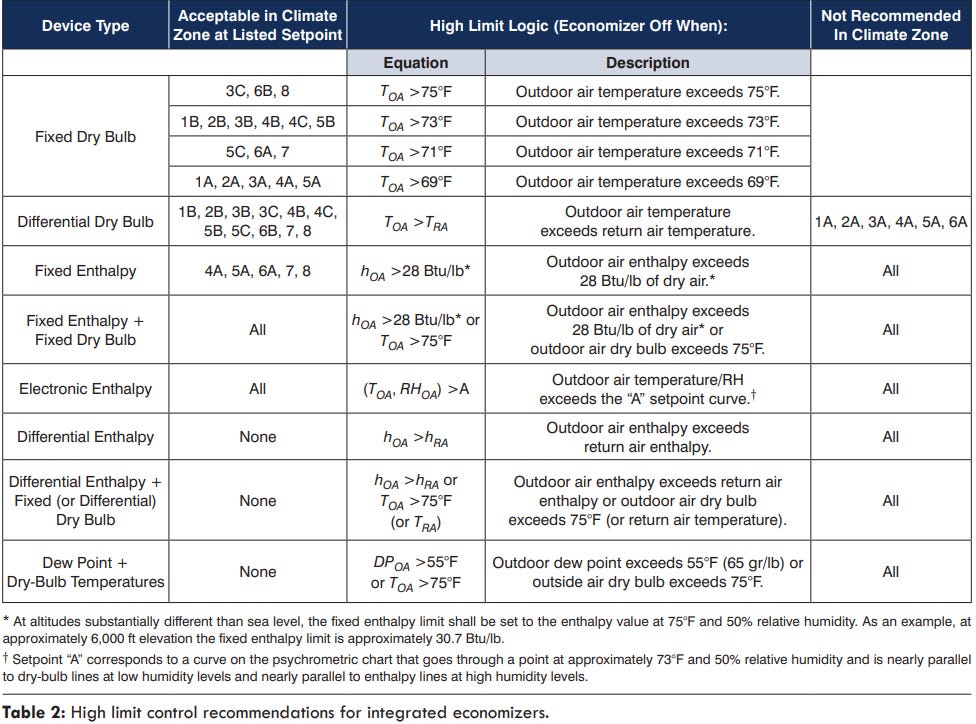BMS reConnect #17: The Best Economizer Control Strategies for 2022.
Maximize free cooling and save.
DISCLAIMER
All opinions in this newsletter are my own.
BASEBALL
I threw some hype towards the Yankees and the amazing season Aaron Judge has been having in my last newsletter. Since that date, the team is 4-13 over their last 17 games and Judge has “only” hit another 4 home runs. So basically, the wheels have fallen off since I wrote about the team 3 weeks ago. Are these things related? Did I curse the Yankees? They went from being about the best team in baseball to about the worst in the flip of a switch, and it coincided with my write up.
But alas, \they just took two against the crosstown rival Mets with Judge hitting long balls in each game. So…maybe things are getting back on track?
Weird the way sports fans think they have the ability to curse their teams, isn’t it?
ECONOMIZER CONTROLS 2022
Air side economizers are one of the most tried and true strategies for driving energy efficiency improvements in commercial HVAC systems. With emerging technologies impacting so many aspects of the HVAC world, are these new technologies impacting how we should be controlling our economizers? I was actually a bit surprised by the answer: no.
For those unfamiliar with the topic, an airside economizer system allows for outside air (OA) to be used in place of operating the compressor on the HVAC system when conditions allow for it. Think of it as a more sophisticated way of “opening up the windows” of your home on a cool, late summer night…its just you are opening an OA damper instead of a double hung Andersen. A schematic is shown below:
An economizer controller monitors several critical points and provides the logic to modulate the OA damper, the return air damper, and stage the compressors on/off so as to deliver an appropriate supply air temperature to the space. And, as with so many applications in the industry, there are multiple ways to skin the cat when it comes to economizer control. Specifically, there are 3 main strategies (which each have a few exotic variations that can be deployed):
OA dry bulb control. This strategy operates the economizer cycle on the basis of OA dry bulb temperature only, without consideration given to humidity. When the outdoor air is below, for example, 60F, the OA damper opens and we get free cooling from the OA.
Enthalpy control. This strategy operates the economizer cycle based on OA enthalpy instead of dry bulb temperature. The theoretical reason for doing so is to avoid bringing OA with excessively high relative humidity into the building. The theory holds that energy savings above and beyond the basic dry bulb strategy can be had if we more tightly control humidity levels.
Dual enthalpy control. This strategy compares the enthalpy value in the OA against the enthalpy value of the return air and opens the damper of whichever air stream will be “easier” for cooling to be achieved with. If it will take less energy to cool the OA, then we let that into the building. If it will take less energy to the cool the RA, we let that into the building. Sounds great in theory.
I was refreshing on some economizer basics earlier this week and I found a great LinkedIn article where an HVAC guy dives into this topic in more detail than I can give it here. His article pointed me over to a 2010 ASHRAE Journal article by Taylor/Cheng that might be considered the definitive write-up on the topic. One of the main contributions of that article was the development of the following table:
Key Takeaways:
Sensor errors can be a major issue impacting the functionality of the control.
Pick the right curve for your economizer setpoint (if using enthalpy). In most climate zones, this will be D (20 BTU/lbs) or C (23 BTU/lbs). End users might want to go with letter C to drive some more energy savings, while contractors will want to go with letter D to avoid call backs.
Differential enthalpy is NOT recommended in most climates/applications.
Plain vanilla dry bulb control is one of the best performers in most climate zones.
There are a few newer control strategies that add additional sensors, but the up-front costs and added complexity don’t seem to pay back reliably.
The KISS rule might well be in effect here.
My experience holds that if your economizer controls are more than about 5 years old, you really should consider giving them a retro-commissioning. Sensor failure and actuator failure are the most common issues we see, and both allow for simple fixes that have excellent ROI on the repair. Give a look at your systems, check if the actuators and sensors are working appropriate, and make sure you are using the right control strategy. This is some of the low hanging fruit most buildings owners should be addressing.
MORE ON VENTILATION
While we are on the topic of economizers/ventilation, it occurred to me that I have never touched on DOAS systems in this space. Here’s a brief overview of the system concept. You will see that it builds on and expands some of the concepts of an economizer system.
If interested in more detail, download the ASHRAE design guide here.
And here is another quick video describing control requirements for DOAS boxes in these systems:
DINOSAURS
I feel everybody should be up to speed with the latest findings out of the field of paleontology in Portugal, which is why I bring you this story. Scientists have just uncovered what is probably the largest dinosaur ever found on the continent of Europe. This is a BIG deal (see what I did there?):
JAM OF THE DAY
DARTS
FYI, we start to get serious about darts again after Labor Day in anticipation of the Hub Lakes winter darts season. More to come, as I have received a lot of feedback about needing more darts-related content on here. To all of my impatient readers that want more darts: I hear you and will be back with you soon.





